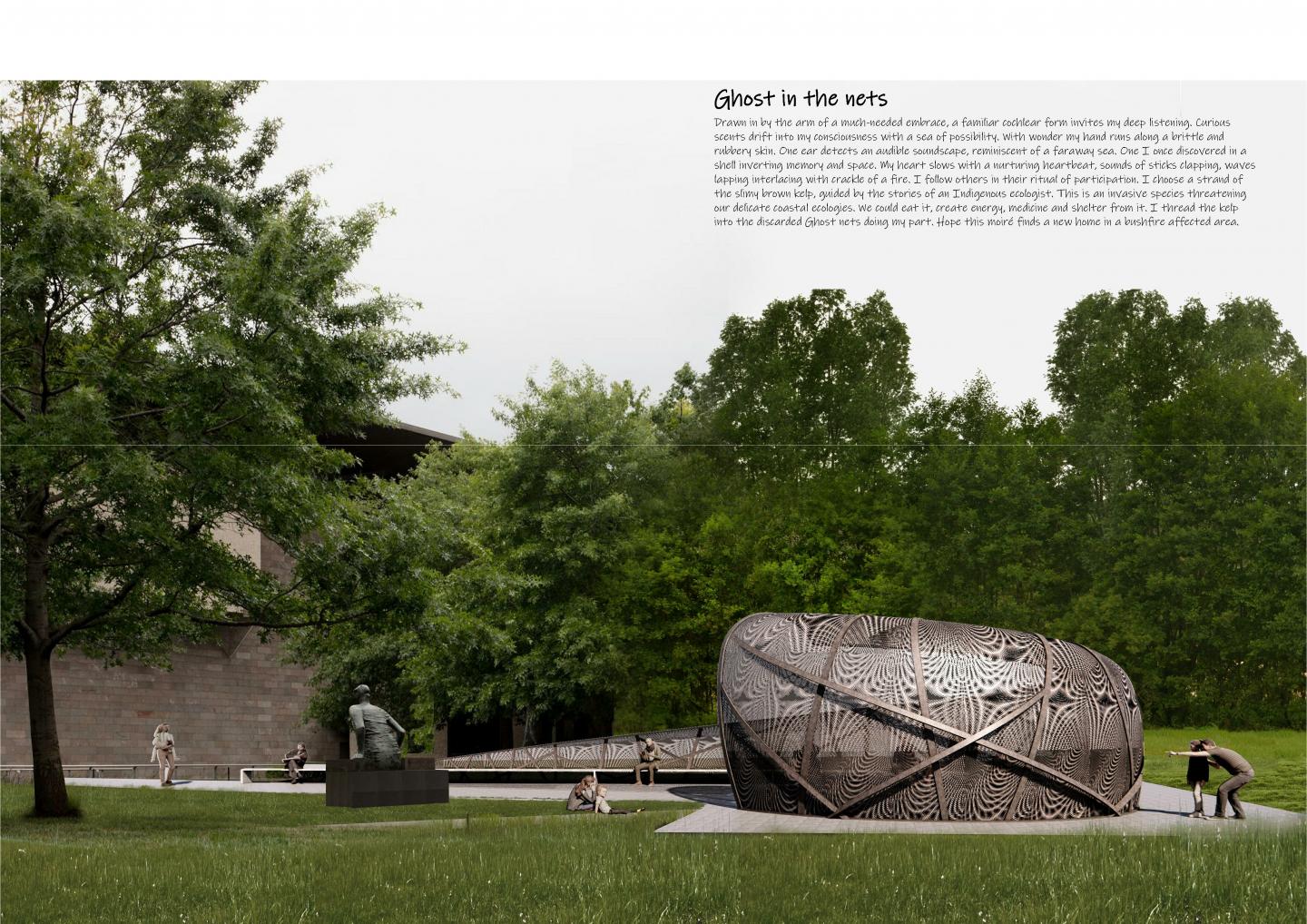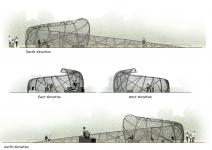Ghost in the net is a project that draws attention to re-using what we think is waste, to reconnect us with nature and to deepen our understanding of indigenous culture. The project is to be experienced by all our senses.
Drawn in by the arm of a much-needed embrace, a familiar cochlear form invites my deep listening. Curious scents drift into my consciousness, a sea of possibility. With wonder, my hand runs along a brittle and rubbery skin. One ear detects a barely audible soundscape. Reminiscent of a faraway sea. The one I once discovered in a shell inverting memory and space. My heart slows with a nurturing heartbeat with sounds of sticks clapping, waves lapping interlaces with the crackle of a fire. I follow others in their ritual of participation. I dunk my hand through a salty crustation of water. I hold repulsion and squeals of delight within. Transported to a time when I discovered the slippery brushing of eels against my skin in unknown waters. I become aware of an urn noble in presence. Its handmade black cement is striated with layers of oysters and mussels. I choose a strand of the slimy brown kelp, guided by the stories of an Indigenous ecologist. This is an invasive species threatening our delicate coastal ecologies. We could eat it, make energy, medicine and shelter from it, solve the problem. I thread the kelp into the discarded Ghost nets, doing my part as a denizen weaving. These nets were collected from Northern Australian fishing villages. I hope this weaving moirée finds a new home as shade for a playground in a bushfire affected coastal school.
2020
2020
Immersive sense-making
Ghost in the net embrace the ephemeral with speculated social imaginaries. With the intention to inspire deep listening, the structure is framed by a cochlea like a form unfolding in time. Led by First Nation creative leadership, the skin of the structure transforms through a participatory denizen weaving. The textural form may be reminiscent of ancient mythological sea creatures that connect the stories of multiple cultures through time and place. The ensemble pays tribute to the temporal, enigmatic Eel trap 2019 by Boon Wurrung artist Mitch Mahoney and Mutti Mutti Wemba Wemba Maree Clarke. Our hope is to inspire similar custodian invitations to expand communities of care. Our aim is to frame metaphoric layering to decolonize, reconcile and indigenize our city with regenerative intervention. In this instance, our attention focuses on co-created sensorial landscape embedded with curious yet familiar sounds, smells, tastes and touchpoints. In particular, make tangible the barely audible connections in the liminal spaces between belonging and becoming.
Ecological Weaving
Ghosts in the net embrace the ephemeral with speculated social imaginaries. With the intention to inspire deep listening, the structure is framed by a cochlea like a form unfolding in time. Led by First Nation creative leadership, the skin of the structure transforms through a participatory denizen weaving. The textural form may be reminiscent of ancient mythological sea creatures that connect the stories of multiple cultures through time and place. The ensemble pays tribute to the temporal, enigmatic Eel trap 2019 by Boon Wurrung artist Mitch Mahoney and Mutti Mutti Wemba Wemba Maree Clarke. Our hope is to inspire similar custodian invitations to expand communities of care. Our aim is to frame metaphoric layering to decolonize, reconcile and indigenize our city with regenerative intervention. In this instance, our attention focuses on co-created sensorial landscape embedded with curious yet familiar sounds, smells, tastes and touchpoints. In particular, make tangible the barely audible connections in the liminal spaces between belonging and becoming.
Regenerative Ecologies
Constructed from laminated timber or lightweight recycled steel transforming plastic waste to fire the smelter processes. The construction methodology of the structure has been designed as a reverse-engineered gift. We hope that it will be reassembled in a Victorian coastal community affected by the bushfires for example.
The invitation upon entry is to collect a strand of kelp to thread in the collective weaving when wet. Our hope is to commission First Nations artist Dale Hardiman, to make an urn similar to the one he made for Wasteland 2019. The combination of Indigenous knowledge and material sciences forming middens highlights contemporary opportunities for waste streams in the local circular economies. The pavilion is adaptive in use for public pedagogy programs at the NGV and its ongoing life cycle. It hopes to attract a diverse range of communities of practice that privilege reciprocity with Indigenous knowledge systems. For instance, it may entice collaborations with Victorian Aboriginal Weaving Collective, Baluk Arts and Australian Tapestry workshop. A talk about decolonized environments and lost landscapes that once offered saltwater and freshwater materials to weave with. It may be used as a backdrop to host a Biodiversity and blue-green circular economy film festival. It could be complemented with Seaweed cocktail making-hour and a family-friendly algae bioplastic workshop by the Seaweed Appreciation Society.
Nadine Samaha, Sarah Naarden, Wei Guo, Lam Le.




